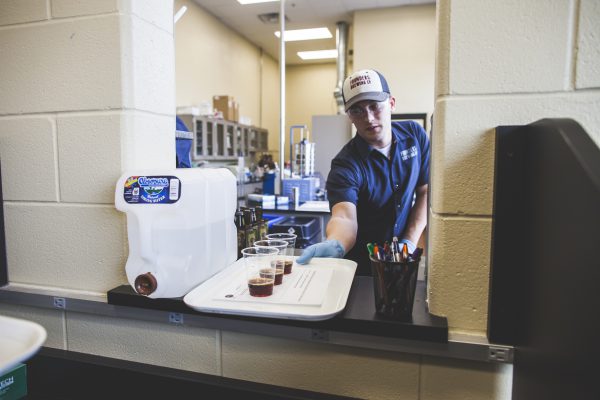Why Pursue Continuous Improvement in Craft Brewing Operations?
Is your craft brewery growing too quickly and having difficulty keeping up with the demand, and you are asking yourself: how can I get more volume capacity from my current brewery? Or, has volume growth begun to stall, competition around you has intensified, and you are asking yourself: how can I continue to make my great beers at a lower cost? Or perhaps your radius of distribution has grown much farther than when you started, and now you’re wondering: how can I consistently make my great quality beers stay fresh longer? Or maybe you received a third-party technical audit report, and you’re concerned about how to ensure product compliance to regulatory expectations and assure consumer product safety?
These are just a few examples of questions that more craft breweries are facing, and they represent the increasing operational complexity, challenges and opportunities of the industry. An enabler to successfully address these needs and opportunities is to have a Continuous Improvement (CI) mindset and process in place at the brewery. In this brief overview, we outline some necessary elements for CI, illustrated with a few examples.
According to the American Society for Quality (ASQ), Continuous improvement “is an ongoing effort to improve products, services or processes. These efforts can seek ‘incremental’ improvement over time or ‘breakthrough’ improvement all at once”. There are a variety of tools available to pursue CI, including the “Plan-Do-Check-Act” cycle, Six Sigma, Lean, and Total Quality Management. Within these tools, at a fundamental level, the use of Statistical Process Control (SPC) is essential to help manage process performance.
Embarking on the implementation of some of these tools can be perceived too cumbersome for a craft brewer, but it need not be so, if one starts by focusing on the most important metrics first.
Key Performance Indicators (KPIs)
The following outlines some basic steps to pursue continuous or continual improvement.
Identify the set of process and product KPIs for the brewery.
One first needs to decide: of all the metrics that you have in the brewery’s operation, which of these are key to ensuring good consumer satisfaction and financial performance? There are a variety of internal metrics: those things that can be measured as the product is made. Examples include:
-
- Brewhouse yield, overall process yield and filler efficiency.
-
- Key product attributes such as alcohol by volume (ABV), carbonation, beer gravity, color, bitterness units (BU), pH, sensory, and microbiological condition.
-
- Water and energy usage, and wastewater generated.
In addition to these, one should also consider including “external” metrics such as
-
- Consumer complaints
-
- Product freshness in the market.
Here are a couple of examples that illustrate the value of including metrics that reflect what happens to the product after it leaves the brewery:
- a) Craft Brewery “A” had grown from a brewpub into a production brewery. And as its radius of distribution began to increase, they found that most product reached store shelves when it was about five weeks old. This prompted the brewer to reconsider how they were going about measuring flavor. While sensory evaluation of the beer in process and in the packaging line are important, the brewer added a sensory evaluation when the product is six weeks old because this would be more representative of what their consumers are seeing. This helped improve the recipe while reducing cost by focusing on those recipe items that made a difference when the majority of their consumers experienced their product.
- b) Craft Brewery “B” conditions several of their products in the keg and bottles prior to shipping. While alcohol and carbonation were within specification when the beer was kegged or packaged, they found that the alcohol and carbonation in some production lots began to increase after 30 to 90 days when stored at ambient temperature. A root cause analysis determined these changes were driven by the presence of Saccharomyces diastaticus contamination. This became a product safety concern for exploding packages. The brewery has since implemented additional microbiological testing, and expanded their sampling plan to regularly measure carbonation and alcohol during the product shelf life.
Verify the quality of the KPI measurements
This next step deals with having adequate confidence in how these KPIs are measured. To gain this confidence, it is beneficial to understand the accuracy and the precision of these measurements. For instance:
- c) Craft Brewery “C” was having difficulties in determining where the biggest opportunity for process yield was. Obtaining process yield data relies on flow meters which can vary in their precision and need for periodic calibration. It was not until flow meters were calibrated, repaired or replaced that the data began to make sense and pointed to fermentation as the biggest opportunity for yield improvement.
- d) Craft Brewery “D” was concerned about excessive variability in carbonation levels. The root cause for this variability was traced back to the lack of adequate periodic calibration of the pressure gauges used in the bright beer tank area and in the final package.
As we can see, having a process in place to ensure that the instruments that are used to measure KPIs are working well is critical. Otherwise, the brewing staff may be unnecessarily reacting to measurement noise, or even worse, failing to react to an inaccurate measurement.
Establish performance tracking and review frequency.
Generating good data on KPIs will bring limited value to your brewery unless this information is proactively used on a regular basis. Tracking and review frequency is important. Some KPIs should be tracked daily to make decisions on a batch to batch basis. In addition, however, tracking or trend analysis should also be done periodically such as once a week and/or once a month. Taking time to do this will enable you to detect and proactively adjust parts of the process when a trend or a drift is noticed. For instance:
- e) Craft Brewery “E”, by simply charting the brewhouse yield data, noticed how yield had a somewhat repeatable pattern: it gradually decreased, followed by a sudden increase, and again a gradual decrease. The root cause was determined to be the frequency with which the malt mill was given preventive maintenance and the roller gaps were adjusted. This analysis prompted the brewer to reconsider the frequency of maintenance for their four-roller malt mill.

Select the KPIs to improve.
There are only so many improvement initiatives that your brewery’s staff can take on at a given time. As part of the KPI performance review process, therefore, it will be important for you to decide: what will be the improvement focus for the next month or two? Prioritization will be necessary: starting with safety, followed by quality, and then efficiency and productivity. As an example:
- f) Craft Brewery “F” had determined that there was excessive variability in the flagship product’s BU, color and ABV. While all three parameters impact beer flavor and consumer-perceived quality, ABV is also a regulatory requirement. In the United States, for instance, the product’s ABV should be within +/- 0.3 % of what is stated on the label. The decision, therefore, was to first focus on addressing ABV variability. The other two parameters would follow a couple of months later.
Follow a process to determine the root cause(s) for the KPI’s performance.
For those KPIs that are selected for improvement, having an effective way to go about finding the potential root causes that drive performance is essential.
One approach that can be helpful is using a Fishbone diagram. This method helps capture many possible causes for a particular problem in a structured way by sorting ideas from a brainstorming session into useful categories. It’s important not to reinvent the wheel. A good place to start would be by checking the collection of Fishbone diagrams that the American Society of Brewing Chemists has available on its website, covering a variety of different brewing topics or issues.
Another useful technique (that sometimes follows the Fishbone exercise) is the “5 Whys” technique. Although there is nothing magic about the number five, by repeatedly asking the question “Why”, one can progress from acknowledging symptoms to nailing down the root cause of a problem. Here’s one example:
- g) As noted earlier, Craft Brewery “F” found they had excessive variability in ABV in their packaged product. When looking at possible root causes, they considered a variety of factors such as variability in: the wort original extract, the yeast pitch rate, the yeast viability, the wort oxygen level, and the wort fermentability. A quick look at the charts for the first four of these parameters revealed that none of them could explain ABV performance and that the issue likely resided in the last one: wort fermentability.
To determine if this was the primary root cause, however, they realized they first needed to implement a simple lab test (ASBC Wort-5) to measure yeast-fermentable extract in wort (also called rapid fermentation). It turned out that indeed wort fermentability was too variable. A new brainstorming session followed and a Fishbone diagram was created where the brewing staff cited possible causes for this issue. Factors included the variability in: the malt’s enzymatic power, water chemistry, mash pH, and mash temperature. Of these, mash temperature was found to be the main or most likely root cause. The 5 Whys technique was then applied. Why was the temperature too variable? Because the mash-in water (liquor) temperature was too variable. And why was the mash-in water temperature too variable? Because the brewer was manually controlling the ratio of cold vs hot water, and the capability of this manual mixing control was at best +/- 2 oF. An improvement to this water mixing system became the answer.
A Culture of Continual Improvement
Just as it would have been difficult ten years ago to imagine the dramatic changes that have taken place in the craft brewing industry, it is equally hard to envision the industry in 2027. It is not hard to imagine, however, the difference that a mindset of continual improvement can do for your craft brewery so that it continues to grow not only in volume, but also in safety, quality and efficiency. Having a designated person who will champion the CI process, with your management’s support and involvement, can make a major positive difference to your brewery’s future.





